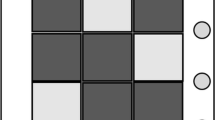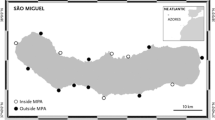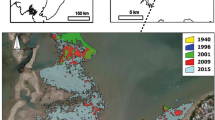Abstract
Non-indigenous marine species often change the abundance and diversity of native species in coastal ecosystems. On the SW Atlantic coast, the macroalgae Ahnfeltiopsis sp. (Rhodophyta, Phyllophoraceae) and Schizymenia dubyi (Rhodophyta, Schizymeniaceae) have invaded the intertidal rocky shore of Mar del Plata, Argentina (38°S, 57°W). To study the spread and ecological associations of these invasive species, algal abundance, biomass and biodiversity of benthic assemblages at three different tidal levels were examined during five years. Sparse Ahnfeltiopsis sp. thalli (3 % cover) were detected in February 2007 at the three tidal levels. By January 2011, its cover had increased to 11 %, while its biomass showed a 27-fold increase. S. dubyi was detected at the lower intertidal level in January 2010 with a cover of 2 %. By January 2011, it had increased to 5 % and spread to the other intertidal levels. The presence of these two non-indigenous algae modified the substrate and the structure and composition of the benthic assemblage. The constant increase in the algal biomass and presence along the intertidal suggest that the effect will be greater in the future. Moreover, the effects of these exotic algae could potentially displace Brachidontes rodriguezii—an important ecosystem engineer that creates microhabitat for a large number of organisms on these shores.





Similar content being viewed by others
References
Airoldi L (1998) Roles of disturbance, sediment stress, and substratum retention on spatial dominance in algal turf. Ecology 79:2759–2770
Airoldi L (2000) Responses of algae with different life histories to temporal and spatial variability of disturbance in subtidal reefs. Mar Ecol Prog Ser 195:81–92
Airoldi L, Beck MW (2007) Loss, status and trends for coastal marine habitats of Europe. In: Gibson RN, Atkinson RJA, Gordon JDM (ed) Oceanography and Marine Biology: An Annual Review 45:345–405, CRC Press
Anderson MJ, Connell SD, Gillanders BM, Diebel CE, Blom WM, Saunders JE, Landers TJ (2005) Relationships between taxonomic resolution and spatial scales of multivariate variation. J Anim Ecol 74:636–646
Arribas LP, Bagur M, Klein E, Penchaszadeh PE, Palomo MG (2013) Geographic distribution of two mussel species and associated assemblages along the northern Argentinean coast. Aquatic Biol 18:91–103
Becherucci ME, Benavides H, Vallarino EA (2014) Effect of taxonomic aggregation in macroalgae assemblages in a rocky shore of Mar del Plata, Argentina, Southwest Atlantic Ocean. Thalassas 30:9–20
Blum JC, Chang AL, Liljesthröm M, Schenk ME, Steinberg MK, Ruiz GM (2007) The non-native ascidian Ciona intestinalis (L.) depresses species richness. J Exp Mar Biol Ecol 342:5–14
Carlton JT (1999) The scale and ecological consequences of biological invasions in the world’s oceans. In: Sandlund OT, Schei PJ, Viken A (eds) Invasive species and biodiversity management. Kluwer Academic Publishers, Dordrecht, pp 195–212
Casas G, Scrosati R, Piriz ML (2004) The invasive kelp Undaria pinnatifida (Phaeophyceae, Laminariales) reduces native seaweed diversity in Nuevo Gulf (Patagonia, Argentina). Biol Invas 6:411–416
Chambers PA, Prepas EE (1993) Nutrient dynamics in riverbeds: the impact of sewage effluent and aquatic macrophytes. Water Res 28:453–464
Clarke KR (1993) Non-parametric multivariate analyses of changes in community structure. Aust J Ecol 18:117–143
Clarke K, Warwick R (2001) Change in marine communities: An approach to statistical analysis and interpretation. PRIMER-E Ltd., Plymouth 82 pp
Critchley AT, Farnham WF, Yoshida T, Norton TA (1990) A bibliography of the invasive alga Sargassum muticum (Yendo) Fensholt. (Fucales, Sargassaceae). Bot Mar 33:551–562
Cuevillas A (2014). Effect of two species of exotic macroalgae on the rocky intertidal coast of Buenos Aires Province. Licenciate Thesis. Universidad de Buenos Aires 62 pp
Davidson AD, Campbell ML, Hewitt CL, Schaffelke B (2015) Assessing the impacts of nonindigenous marine macroalgae: an update of current knowledge. Bot Mar 58:55–79
Dayton PK, Currie V, Gerrodette T, Keller BD, Rosenthal R, Tresca DV (1984) Patch dynamics and stability of some California kelp communities. Ecol Monogr 54:253–289
Engelen AH, Henriques N, Monteiro C, Santos R (2011) Mesograzers prefer mostly native seaweeds over the invasive brown seaweed Sargassum muticum. Hydrobiologia 669:157–165
Fiore MME, D´Onofrio EE, Pousa JL, Schnack EJ, Bertola GR (2009) Storm surges and costal impacts at Mar del Plata, Argentina. Cont Shelf Res 29:1643–1649
Fowler-Walker MJ, Connell SD (2007) Habitat heterogeneity as a consequence of substratum-orientation and kelp-canopy: relating interdependent responses to common patterns. J Exp Mar Biol Ecol 343:127–137
Giménez L, Venturini N, Kandratavicius N, Hutton M, Lanfranconi A, Rodríguez M, Brugnoli E, Muniz P (2014) Macrofaunal patterns and animal-sediment relationships in Uruguayan estuaries and coastal lagoons (Atlantic coast of South America). J Sea Res 87:46–55
Goldberg NA, Foster MS (2002) Settlement and post-settlement processes limit the abundance of the geniculate coralline alga Calliarthron on subtidal walls. J Exp Mar Biol Ecol 278:31–45
Gray JS (1997) Marine biodiversity: patterns, threats and conservation needs. Biodivers Conserv 6:153–175
Guerrero RA, Piola AR (1997) Water masses in the continental shelf. In: Mar El (ed) Boschi IEE. Argentino y sus Recursos Pesqueros, INIDEP Mar del, Plata, pp 107–119
Guichard F, Bourget E (1998) Topographic heterogeneity, hydrodynamics, and benthic community structure: a scale-dependent cascade. Mar Ecol Prog Ser 171:59–70
Gutiérrez JL, Palomo MG, Bagur M, Arribas LP, Soria SA (2015) Wave action limits crowding in an intertidal mussel. Mar Ecol Prog Ser 518:153–163
Hay CH (1990) The dispersal of sporophytes of Undaria pinnatifida by coastal shipping in New Zealand, and implications for further dispersal of Undaria in France. Brit Phycol J 25(4):301–313. doi:10.1080/00071619000650331
Hewitt CL, Campbell ML, Schaffelke B (2007) Introductions of seaweeds, accidental transfer pathways and mechanisms. Bot Mar 50: 326–337
Irving A, Connell S (2002) Sedimentation and light penetration interact to maintain heterogeneity of subtidal habitats: algal versus invertebrate dominated assemblages. Mar Ecol Prog Ser 245:83–91
Isaeus M, Malm T, Persson S, Svensson A (2004) Effects of filamentous algae and sediment on recruitment and survival of Fucus serratus (Phaeophyceae) juveniles in the eutrophic Baltic Sea. European J Phycol 39:301–307
Isla FI, Ferrante A (1997). Corrientes. In: Isla, FI. (ed), Estudio del sector de plataforma receptor de la descarga cloacal de Camet, Mar del Plata. Chapter 5. pp. 63-116. Facultad de Ciencias Exactas y Naturales, Universidad Nacional de Mar del Plata
Janiak DS, Whitlatch RB (2012) Epifaunal and algal assemblages associated with the native Chondrus crispus (Stackhouse) and the nonnative Grateloupia turuturu (Yamada) in eastern Long Island Sound. J Exp Mar Biol Ecol 413:38–44. doi:10.1016/j.jembe.2011.11.016
Jaubet ML, Garaffo GV, Sánchez MA, Elías R (2013) Reef-forming polychaetes outcompetes ecosystem engineering mussels. Mar Pollut Bull 71:216–221
Jones CG, Lawton JH, Shachak M (1994) Organisms as ecosystem engineers. Oikos 69:373–386
Kinlan BP, Steven D, Gaines SD, Lester SE (2005) Propagule dispersal and the scales of marine community process. Diversity Distrib 11:139–148
Lohse DP (1993) The importance of secondary substratum in a rocky intertidal community. J Exp Mar Biol Ecol 166:1–17
Maggi E, Benedetti‐Cecchi L, Castelli A, Chatzinikolaou E, Crowe T P, Ghedini G, Kotta J, Lyons DA, Ravaglioli C, Rilov G, Rindi L and Bulleri F (2015). Ecological impacts of invading seaweeds: a meta‐analysis of their effects at different trophic levels.Divers Distrib 21: 1-12
Mann K (1973) Seaweeds: their productivity and strategy for growth. Science 182:975–981
Mazzoni MM, Spalletti LA (1978) Evaluación de los procesos de transporte de arenas litorales bonaerenses a través de análisis texturales y mineralógicos. Acta Oceanogr Argent 2:51–67
Meretta PE, Matula CV, Casas G (2012) Occurrence of the alien kelp Undaria pinnatifida (Laminariales, Phaeophyceae) in Mar del Plata, Argentina. Bioinvasions Rec 1:59–63
Mineur F, Johnson MP, Maggs CA, Stegenga H (2006) Hull fouling on commercial ships as a vector of macroalgal introduction. Mar Biol 151:1299–1307
Ojaveer H, Galil BS, Campbell ML, Carlton JT, Canning-Clode J, Cook EJ et al (2015) Classification of Non-Indigenous Species Based on Their Impacts: considerations for Application in Marine Management. PLoS Biol 13:e1002130
Olivier SR, Escofet A, Orensanz JM, Pezzani S, Turro AM, Turro ME (1966) Contribución al conocimiento de las comunidades bénticas de Mar del Plata. I. El litoral rocoso entre Playa Grande y Playa Chica. Anales de la Comisión de Investigaciones Científicas de la Provincia de Buenos Aires 7:185–206
Orensanz JM, Schwindt E, Pastorino G, Bortolus A, Casas G, Darrigran G, Elías R, Lopez Gappa JJ, Obenat S, Pascual M, Penchaszadeh P, Piriz ML, Scarabino F, Spivak E, Vallarino EA (2002) No longer the pristine confines of the world ocean: a survey of exotic marine species in the southwestern Atlantic. Biol Invasions 4:115–143
Osman RW, Whitlatch RB, Malatesta RJ (1992) Potential role of micro-predators in determining recruitment into a marine community. Mar Ecol Prog Ser 83:35–43
Parma A, Pascual M, Sar E (1987) Clave para el reconocimiento de los géneros de algas macrófitas del intermareal rocoso bonaerense. Serie técnica y didáctica. Universidad Nacional de La Plata. No 15, 29
Pearse JS, Hines AH (1979) Expansion of a central California kelp forest following the mass mortality of sea urchins. Mar Biol 51:83–91
Penchaszadeh PE, Scelzo MA, Palomo MG, Cuevas M, Cledón M (2007) A review of the intertidal rocky shore community at Mar del Plata (Argentina) characterized by the mussel Brachidontes rodriguezii (d’Orbigny 1846). Publ. Seto. Mar. Biol. Lab. 8:115–123
Ramirez ME, Nuñez JD, Ocampo EH, Matula CV, Suzuki M, Hashimoto T, Cledón M (2012) Schizymenia dubyi (Rhodophyta, Schizymeniaceae), a new introduced species in Argentina. New Zeal J Bot 50:51–58
Ricciardi A (2001) Facilitative interactions among aquatic invaders: is an” invasional meltdown” occurring in the Great Lakes? Can J Fish Aquat Sci 58:2513–2525
Rigby PR, Iken K, Shirayama Y (2007) Sampling biodiversity in coastal communities: NaGISA protocols for seagrass and macroalgal habitats. Kyoto University Press, Kyoto
Robinson TB, Griffiths CL, McQuaid CD, Rius M (2005) Marine alien species of South Africastatus and impacts. African. J Mar Sci 27:297–306
Ruiz GM, Carlton JT, Grosholz ED, Hines AH (1997) Global invasions of marine and estuarine habitats by nonindigenous species: mechanisms, extent, and consequences. Am Zool 37:621–632
Sala OE, Chapin FS III, Armesto JJ, Berlow E, Bloomfield J, Dirzo R, Huber-Sanwald E, Huenneke LF, Jackson RB, Walker M, Wall DH (2000) Global biodiversity scenarios for the year 2100. Science 287:1770–1774
Sanderson JC (1990) A preliminary survey of the distribution of the introduced macroalga, Undaria pinnatifida (Harvey) Suringer on the East Coast of Tasmania, Australia. Bot Mar 33: 153–157
Scheibling RE, Anthony SX (2001) Feeding, growth and reproduction of sea urchins (Strongylocentrotus droebachiensis) on single and mixed diets of kelp (Laminaria spp.) and the invasive alga Codium fragile ssp. tomentosoides. Mar Biol 139:139–146
Schmidt R, Wunsam S, Brosch U, Fott J, Lami A, Löffler H, Marchetto A, Müller HW, Pražáková M, Schwaighofer B (1998) Late and post-glacial history of meromictic Längsee (Austria), in respect to climate change and anthropogenic impact. Aquat Sci 60:56–88
Simberloff D (2006) Invasional meltdown 6 years later: important phenomenon, unfortunate metaphor, or both? Ecol Lett 9:912–919
Simberloff D, Von Holle B (1999) Positive interactions of nonindigenous species: invasional meltdown? Biol Inv 1:21–32
Sindermann CJ (1991) Case histories of effects of transfers and introductions on marine resources. ICES J Mar Sci 47:377–378
Stachowicz JJ, Whitlatch RB, Osman RW (1999) Species diversity and invasion resistance in a marine ecosystem. Science 286:1577–1579
Thomsen MS, Byers JE, Schiel DR, Bruno JF, Olden JD, Wernberg T, Silliman BR (2014) Impacts of marine invaders on biodiversity depend on trophic position and functional similarity. Mar Ecol Prog Ser 495:39–47
Vitousek PM, Mooney HA, Lubchenco J, Melillo JM (1997) Human domination of Earth’s ecosystems. Science 277:494–499
Wells ML, Trainer VL, Smayda TJ, Karlson BS, Trick CG et al (2015) Harmful algal blooms and climate change: learning from the past and present to forecast the future. Harmful Algae 49:68–93
Widdows J, Fieth P, Worrall CM (1979) Relationships between seston, available food and feeding activity in the common mussel Mytilus edulis. Mar Biol 50:195–207
Wikstrӧm SA, Kautsky L (2004) Invasion of a habitat-forming seaweed: effects on associated biota. Biol Invas 6:141–150
Williams SL, Smith JE (2007) A global review of the distribution, taxonomy, and impacts of introduced seaweeds. Annu Rev Ecol Evol Syst 38:327–359
Zar JH (1984) Biostatistical analysis. Prentice-Hall, Englewood Cliffs
Acknowledgments
The manuscript was enriched with the useful comments of two anonymous reviewers. We are grateful to M.G. Chapman for the comments on an early version of this article. This is a contribution to the program of GrIETA. We thank Eleonor Tietze and Diana Montemayor for field assistance.
Author information
Authors and Affiliations
Corresponding author
Ethics declarations
Funding
This study was partly funded by two CONICET grants (Consejo Nacional de Investigaciones Científicas y Técnicas; PIP 11220080100732 and 11220110100024) to MGP, by Census of Marine Life (NaGISA project) and by Total Foundation funds to the South American Research Group on Coastal Ecosystems (SARCE).
Conflict of interest
All authors declared that they have no conflict of interest.
Ethical approval
This article does not contain any studies with animals performed by any of the authors.
Additional information
Responsible Editor: E. Briski.
Reviewed by J. C. Creed and an undisclosed expert.
This article is part of the Topical Collection on Invasive Species.
Electronic supplementary material
Below is the link to the electronic supplementary material.
Rights and permissions
About this article
Cite this article
Palomo, M.G., Bagur, M., Quiroga, M. et al. Ecological impacts of two non-indigenous macroalgae on an urban rocky intertidal shore. Mar Biol 163, 178 (2016). https://doi.org/10.1007/s00227-016-2951-6
Received:
Accepted:
Published:
DOI: https://doi.org/10.1007/s00227-016-2951-6




